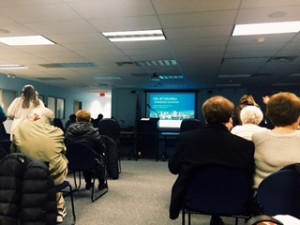We attended the City of Columbus Development Commission Meeting on February 11th at the I-71 North Complex. The meeting was to hear various requests for pleas to rezone areas throughout Columbus and receive approval for new development plans. The board of 8 members oversaw a meeting that was over two hours long and promoted open report between both sides of opposing arguments, if an opposition existed at all. The structure of the meeting was to ensure a concise and effective decision making process. Approximately 50 people were in attendance that night and they filled the majority of the seats. The demographic of the room was predominately older citizens, but we later learned that the mean age of a community at questioned to be rezoned was of older age. The room had the officials sitting across from each other in front of a large projector for presentations.
Those on the board were made up of 4 men and 2 women, the head of the board abstained from voting unless there was a tie to keep it an uneven number. The atmosphere of the room was professional but also casual, those in charge made jokes when appropriate. Yet still, when it came to time to hear a case and making a decision they took every detail extremely seriously. Overall it was a very cooperative environment. Many of the changes were simple and non-intrusive to others, leaving very little reason for an adversarial attitude. Two of the cases produced some hostile reactions from those in the audience; however, as discussed in class, often when a change so close to home occurs, individuals and groups can become very protective and suspicious of those making those changes.
The procedure of the meeting was to present each case to the room with a quick overview of the site, what variances were being requested, how those variances differed from the suggested zoning uses for the area. This was followed by a description of what the area was surrounded by, with photos included, and finally whether or not it had been suggested for approval or not by the lower boards before them. The board would then ask if there was anyone in attendance to speak for the cases. Often there was one person there to represent the changes that were being requested, they often did nothing besides introduce themselves if the board did not have questions for them, and if there was no one present in opposition of the variance. Once the board had reviewed the matter it was voted on and either approved or not. In all of the cases that we witnessed they were all approved except one.
A case that stuck out to us was the construction of a Monopole telecommunications antenna at 441 Lazelle Road. The variance requested a removal of the height restrictions for the area where the tower was to be built. The case was presented to the room, and when asked if there were those in attendance who wished to speak on the matter two women spoke up. These women lived just south of where the tower was to be built and felt very strongly that its construction would negatively impact their abilities to resell their properties. The women commented that there was already a tower quite near their homes that impacted their property values already. They also expressed concerns about the health effects of living so close to a large cell tower.
In defense of the case was the business that wished to build the antenna. In reply to the women’s concerns they stated that though there is a tower already nearby this one would provide better service, due to it being more advanced as well as its capability to allow three users instead of one.They also noted that this was the first time they had heard of any opposition to the antenna being constructed. They also stated that they had met the minimum requirements for a setback from the properties with some “cushion” space as well. The defendants stated that soon there would be condos built in between the tower and where the women lived, blocking their view of the antenna from their homes.
The head of the board asked the company if there was any risk of the antenna falling and hitting anything. The company stated that the antenna was designed to collapse on itself if ever the wind speeds reached speeds high enough to damage the tower to that point. The only way the tower could fall is if it was unbolted from its foundation. The owner also stated that there would be a fence with green space surround the bottom of the tower as per regulations.
The board then called for a vote concluding with six yes’s, their reasoning being that condos would soon be built in between the two properties.
A question that I, as an audience member, was left with was whether or not the tower would still meet the necessary setbacks once the new condos were built.
